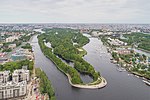Kamenny Island Theatre
1826 establishments in the Russian EmpireEuropean theatre stubsTheatres in Saint Petersburg

The Kamenny Island Theatre (also known as the Stone Island Theatre, in Russian: Каменноостровский театр) is a wooden theatre on the grounds of the Kamennoostrovsky Palace, Kamenny Island, Saint Petersburg, Russia. It is the only surviving wooden theatre in St. Petersburg, and one of the few remaining in Europe. The theatre is a world heritage site protected by UNESCO.Since 2005, the theatre is home to a second stage of the Bolshoi Drama.
Excerpt from the Wikipedia article Kamenny Island Theatre (License: CC BY-SA 3.0, Authors, Images).Kamenny Island Theatre
набережная реки Крестовки, Saint Petersburg Ostrova (округ Чкаловское)
Geographical coordinates (GPS) Address Nearby Places Show on map
Geographical coordinates (GPS)
| Latitude | Longitude |
|---|---|
| N 59.976404 ° | E 30.274673 ° |
Address
набережная реки Крестовки 12
197110 Saint Petersburg, Ostrova (округ Чкаловское)
Saint Petersburg, Russia
Open on Google Maps









